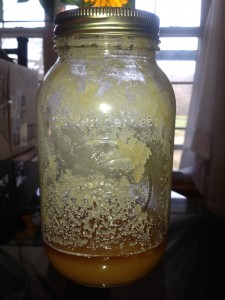This is just turning into a regular little series, isn’t it? “What’s in YOUR ______?” I try not to be paranoid or overzealous, but with my new FPIES Eyes, I’m finding more and more things to be disgusted about regarding our food/consumable goods supply. So, I guess I’ve accidentally started a ‘thing’, because I absolutely want to share what I learn with you!
Today, I’m talking honey. Bee Poop. (Or bee vomit, to be more precise.)
And my little post should probably be called “What’s NOT in YOUR Honey?” to be most accurate.
This honey post came about because I recently read an article in Mother Earth News (reprinted from Food Safety News) about “Honey Laundering“, calling a recent US government ‘sting’ (ha – good pun!) “Honeygate“.
Basically, the article contends, grocery store honey is so finely processed and filtered that it has removed all evidence of where it came from and can no longer be traced to its origins. This means countries which are banned or strictly limited to export honey to the US can possibly “launder” their honey through other countries and get it on our supermarket shelves, anyway. And no one can tell, because the pollen has been removed!
This is problematic, as China is one of the worlds’ largest honey exporters, and they often use pesticides and antibiotics that are banned in the US, often have lead contamination of their food through various means, and beyond health concerns, can seriously undercut American honey farmers cost-wise, causing American honey-bee farmers to go out of business.
Furthermore, the removal of all the pollen and identifying markers means that it is possible for producers to actually “cut” their honey with cheaper sweeteners, like corn syrup, and no one can tell – even with laboratory testing.
No Bueno!
This sounds terrible, right? So I wanted to read more about it. I looked up “Honey from China” on Google and found an NPR article called “Relax, Folks, It Really Is Honey After All.” After reading this article, one might suppose that Food Safety News is just an ambulance chasing, litigation-happy sounding board and that really, as far as honey is concerned, we have nothing to worry about at all! (Go read it and see what I mean.)
Until I read the comments.
Overwhelmingly, the comments were disappointed with NPR’s lack of research and dismissive tone, and many of the comments pointed out little known facts about honey that I had never heard about.
Things like, there is NO Standard Identification of Honey in the US, and the FDA has refused – twice – to adopt the Codex Alimentarius Standard regarding honey.
I can read your mind; you’re saying “No what??”
I know, because that’s what I said, too. So I looked it up.
According to The Journal of Agrobiotechnology Management and Economics, the Codex Alimentarius is a group formed under the World Health Organization (WHO) and the Food and Agriculture Organization (FAO)
(1) to protect the health of consumers, and (2) to promote fair practices in the food trade. These goals are accomplished by development of food standards, food guidelines, codes of hygienic practices, and other actions.
Their Standard for Honey is pretty clear-cut:
Honey is the natural sweet substance produced by honey bees from the nectar of plants or from secretions of living parts of plants or excretions of plant sucking insects on the living parts of plants, which the bees collect, transform by combining with specific substances of their own, deposit, dehydrate, store and leave in the honey comb to ripen and mature.
Honey consists essentially of different sugars, predominantly fructose and glucose as well as other substances such as organic acids, enzymes and solid particles derived from honey collection. The colour of honey varies from nearly colourless to dark brown. The consistency can be fluid, viscous or partly to entirely crystallised. The flavour and aroma vary, but are derived from the plant origin.
Furthermore, they go on to say that, in order for “honey” to actually BE “honey”, it must meet these standards:
Honey sold as such shall not have added to it any food ingredient, including food additives, nor shall any other additions be made other than honey. Honey shall not have any objectionable matter, flavour, aroma, or taint absorbed from foreign matter during its processing and storage. The honey shall not have begun to ferment or effervesce. No pollen or constituent particular to honey may be removed except where this is unavoidable in the removal of foreign inorganic or organic matter.
Honey shall not be heated or processed to such an extent that its essential composition is changed and/ or its quality is impaired.
Chemical or biochemical treatments shall not be used to influence honey crystallisation.
Then it starts getting really technical about the water and sugar content of honey, so I’ll move along. If you’re interested in that, by all means read the Codex!
It seems to me there are two problems here: a financial problem, and a quality of product problem.
Financially, this pollen removal is a problem because Chinese honey is SO much cheaper than US, locally produced honey that it causes our local honey producers to sometimes go out of business. That’s not healthy for our country’s financial health.
As far as quality of product goes, it’s more complicated.
People don’t know what REAL honey is supposed to be like any more. American consumers want honey that is free-flowing, clear, a uniform color, and has no crystallization. They expect that honey isn’t honey unless it has been watered down, de-foamed, or had some other chemical process done to it.
This ignorance is frightening, and dangerous, but we can’t really blame the general population, can we? What we’ve been sold in the stores for the last thirty years has taught Americans what honey looks/tastes/feels like, and why should they think the truth is so very different? (This is why having FDA approval of the Codex is SO important!)
The removal of pollen and the pasteurization of honey is essentially the removal of much of the vital nutritional benefit of honey. It may make it cleaner looking and more free-flowing, but it also removes the natural yeast and enzymes in honey that make it such a power-house healer for our bodies.
One of the many benefits of honey is its ability to provide immunotherapy for environmental allergies. When the pollen is removed from honey, it no longer provides that benefit as the pollen is what provides that benefit in the first place!
For FPIES and Food Allergic Families, a HUGE concern with all this filtration and pasteurization is that by putting honey through these processes, it makes the end product so clean and pristine that the manufacturers are then able to easily “cut” the honey with other sweeteners – like corn syrup – to reap a bigger financial reward.
That can cause allergic reactions – possibly even fatal – if you are allergic to something they have added (unnecessarily) to the honey in order to earn an extra 10 cents per bottle. There is no way to protect yourself from this with supermarket honey, either; with no definition of honey, manufacturers could bottle golden colored corn syrup and label it honey if they wanted. Adding a “May contain” warning on a bottle of honey is not going to happen in this situation.
So as for product quality:
- Americans are largely ignorant of there even being a problem with honey quality
- there is no legal standard by which honey can be defined
- pasteurization, filtration and processing honey removes natural yeast, enzymes and pollen – all of which are greatly beneficial to the health of a human body
- honey that is so processed is often “cut” with other sweeteners, making it not really honey at all
Whether you wish to debate whether the Food Safety News article is correct in its concerns about Chinese honey, or if you agree that NPR has it right and that we have nothing to worry about, I think the REAL question I had while reading these articles is: why is it possible for there to BE such debate about honey?
If there were a legal standard, an FDA definition of “Honey” that ALL manufacturers and producers had to adhere to, then this would not be such a hotly debated, gray area of the food world.
So why hasn’t the FDA approved the twice-petitioned Codex? I don’t know, though in my humble opinion, it surely comes back to some form of financial benefit to the US Government to NOT define “honey”. (The Washington Post quoted an FDA official who said “…it would tax an already overtaxed system” – meaning the FDA is overworked and can’t keep up with the laws it already is supposed to uphold, and can’t possibly add anything else to its workload right now. How’s THAT for a sobering thought?)
For our sake, for the US Honeybee Keepers, for US Honeybees, we need the FDA to define honey. (Contact the FDA here.)
We need to shop LOCALLY, as much as possible, but especially for honey. (See links at the bottom of this post.)
We need to insist on CLEAR FOOD LABELING LAWS for ALL our food.
__________
Two small caveats: We don’t actually eat honey in my house any more. Mr. Charm is Fructose Malabsorbative and honey is high in fructose, so he can no longer have it. The Geek just isn’t a big honey eater. And while I love honey, I’m on a strict elimination diet. However, I hope to one day be able to eat honey again, and when that day comes, I’m buying local, raw, unpasteurized honey. As always, do NOT feed raw honey to a child under the age of 1. Raw honey contains enzymes, bacteria, yeast and other goodies that are helpful for our bodies…but a young child does not have the ability to fight back if there are any strains of botulism in the honey they consume. So for safety’s sake, wait until the child is older before giving them raw honey.__________
TO FIND RAW HONEY:
The Honey Locator by the National Honey Board
__________
This post shared with Allergy Free Wednesdays, Whole Food Wednesdays, and Real Food Wednesdays.












We buy ours from Bubba. 🙂
http://www.bubbasbeez.com/
Oh wow! Talk about local and AWESOME!!! Supporting a kiddo and getting the best kind of honey out there. This is GREAT!!! (Can you tell I’m excited by this kid?) 🙂